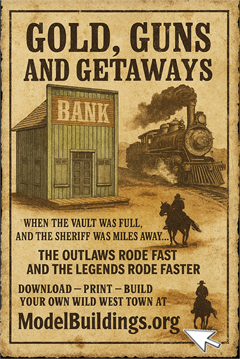Everything on model trains, model railroads, model railways, locomotives, model train layouts, scenery, wiring, DCC and more. Enjoy the world's best hobby... model railroading!
Wiring Street Lights and Buildings
Donald asks readers:
“I have wired my N scale building interiors with 12 V. bulbs to the 18 volt A.C. connections on a power pack under my layout. I wired them in ‘series’, 2 at a time. This cuts the voltage down to 9 volts per bulb. One bulb does each building Great. More realistic lighting inside, and saving bulb life with 3 volts less on each build. Last week-end, I added street lights, wiring them in the same fashion, on both sides of my layout.
However, one side works reliably whenever the power bar is turned on. The other side can be intermittent. When I installed them, they worked Great. Yesterday they wouldn’t come on at all. This morning, I turned on the power bar, and all street lights on both sides of the layout lit. Where should I look for my ‘loose connection. All bulbs are soldered connections. Any ideas?”
Use the comments link to share your ideas and/or a related photo.
5 Responses to Wiring Street Lights and Buildings
Leave a Reply















I’m sure you know that with things wired in series when one goes out all the others in that series will do the same. The first place I would look for the problem is a cold solder joint. As it warms up the connection can fail. Look to see if any solder coints look dull because that is your likely problem.
It will help us to diagnose if you can add a circuit diagram so that we can clearly see your circuit.
The fact that a whole section fails all at once indicates the problem is either:
1) in one of the wires running to that section.
2) in the power supply for that section.
Do you have a test meter ? Even a car 12-24 circuit tester will be very useful here.
(At least one of these is essential for layout testing !)
(Or you can make a tester by soldering two long wires on a 24V bulb (or two 12V).
Connect one lead of your meter (on AC volts range) or circuit tester to one side of the 18V supply.
(Car 12-24V bulb-type circuit testers are happy with AC or DC)
Put the other probe on each accessible point in the other supply wire to see whether there is voltage there. Repeat if necessary on the other wire.
The break will be between the two points where there is, and isn’t, a voltage.
Another simple test: Switch power on and wiggle each connection and solder joint and terminal in the circuit to see what makes a difference.
I use led lights for my set up,endless possibilities,battery powered 3 volt [2 double A batteries] powers many leds ,you may power from the track as well,they don’t produce any heat @ all. i also added leds to my locos & to some rolling stock as well including assorted vehicles in my lay out ,replaced incandescent bulbs for the street lamps with leds. I use the universal leds & power them of the track for track side lighting. I hope this helps
I wire lights in the following manner.
Run a positive and negative bus to each area.
Connect each light to the bus. Power them using an old dc controller just knock back the output voltage a bit.
I used an old tri ang controller set to output 8 volts on the controlled output. Have not blown a bulb in more than a decade and if one does die only that one will go out.